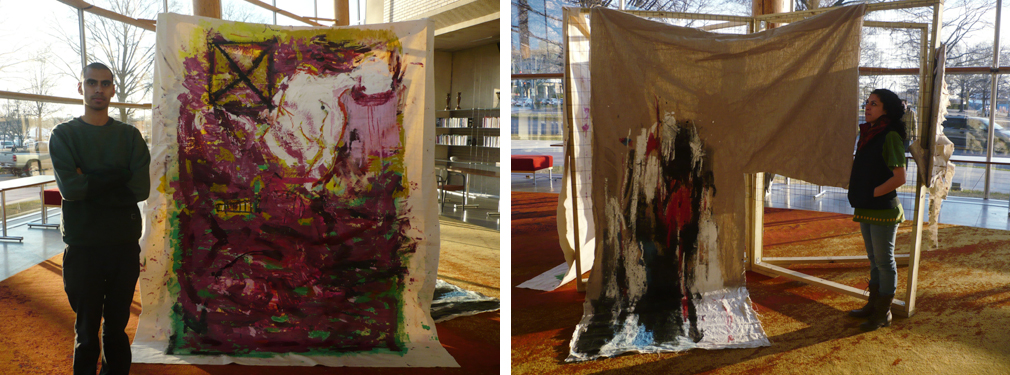Briefly augmenting the Tony Award-winning play, Red, by John Logan, at Washington, D.C.’s Arena Stage, were a dozen works inspired by the grand, colorful paintings of Mark Rothko, who is the focus of the play.
Two Museum Assistants at The Phillips Collection were among the artists in the “Seeing Red” display, organized by Joseph Orzal and Josef Palermo of the Washington art collective, Vestibule. The works were on view February 3-5, 2011.
Experiment Station talked with Museum Assistants Janelle Ortiz and Rodrigo Carazas Portal about their works in the display.

Rodrigo Carazas (left) and Janelle Ortiz (right) stand by their works installed at Arena Stage in February 2011. Photos: Rodrigo Carazas Portal
You’re familiar with paintings in the Rothko Room at the Phillips, and I heard you went to the Phillips library to look through the books on Rothko. Is the Phillips your first exposure to Rothko?
Janelle: The Phillips Collection is not my first exposure to Rothko. I actually cannot even pinpoint in my memory when I first learned about Rothko or first saw a painting of his. However, the Rothko Room was my first EXPERIENCE with a Rothko. Previously, I passively viewed them at art museums; this was before I viewed the Rothko Room or did any research on the artist and his work. The way the Rothko Room presented his paintings requires real consideration from the viewer, a consideration I had never given before to a work by Rothko.
Rodrigo: Mark Rothko is a continuous inspiration for me. Working at The Phillips Collection gave me a much closer approach to his work, and the library [provided] a deeper insight on his life and ideas.
Is Rothko the inspiration for the work?
Janelle: Yes, Rothko as a person, an artist, and the play, Red, are the inspirations. [And] Rothko’s ideologies on art and life, as well.
Rodrigo: Yes, his work and his statement are the start[ing] point[s] of my painting. I try to decode his words and colors into a yawp of expression and content over the canvas. My work is a response to Rothko’s quest.
Janelle: Each artist . . . [worked] individually . . . . However, we hope[d] for our works to unite based upon Rothko’s ideas on what is necessary in a painting and his artistic philosophy.
Rodrigo: . . . We all worked separately on our pieces with continuous exchange of ideas at meetings.
Is there more pressure doing commissioned work?
Janelle: At first the project felt like an assignment, so there was pressure. Once I researched Rothko and found a lot of things I could relate to within his ideas and his passion, it was easy to go forth. I just started painting and his ideas coincided with my own. I wanted the paint to be paint and the process, the action, not too [controlled] by my thoughts. However, I did spend a lot of time looking at the work and really considering what was happening after each time I worked on it, something I took from Rothko.
Rodrigo: There is always the fear [of] the void of the canvas that every painter faces. The idea that this void needs to be filled out with a commissioned idea is a pressure and a relief. Pressure to get the work done under the commissioned standards, and it is a peculiar relief, a relief that you, as an artist, are not intended to find the direction to the piece. The Phillips Collection library made my research easier, as did the librarian. These processes helped shape my work from an early stage.
Janelle: I learned of this project through a friend, Joseph Orzal. He needed some “BIG ART” for this show, and it needed to be inspired by Red and Rothko.
Rodrigo: Vestibule is an art collective organized by Joseph Orzal and Josef Palermo that has produced a variety of art exhibitions since last year. I got involved as part of the project.
